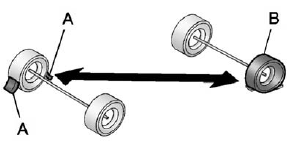If a Tire Goes Flat
It is unusual for a tire to blow out while driving, especially if the tires are maintained properly. See Tires on page 10‑37. If air goes out of a tire, it is much more likely to leak out slowly. But if there is ever a blowout, here are a few tips about what to expect and what to do:
If a front tire fails, the flat tire creates a drag that pulls the vehicle toward that side. Take your foot off the accelerator pedal and grip the steering wheel firmly. Steer to maintain lane position, and then gently brake to a stop, well off the road, if possible.
A rear blowout, particularly on a curve, acts much like a skid and may require the same correction as used in a skid. Stop pressing the accelerator pedal and steer to straighten the vehicle. It may be very bumpy and noisy. Gently brake to a stop, well off the road, if possible.
WARNING
Driving on a flat tire will cause permanent damage to the tire.
Re-inflating a tire after it has been driven on while severely underinflated or flat may cause a blowout and a serious crash.
Never attempt to re-inflate a tire that has been driven on while severely underinflated or flat.
Have your dealer or an authorized tire service center repair or replace the flat tire as soon as possible.
WARNING
Lifting a vehicle and getting under it to do maintenance or repairs is dangerous without the appropriate safety equipment and training. If a jack is provided with the vehicle, it is designed only for changing a flat tire. If it is used for anything else, you or others could be badly injured or killed if the vehicle slips off the jack. If a jack is provided with the vehicle, only use it for changing a flat tire.
If a tire goes flat, avoid further tire and wheel damage by driving slowly to a level place, well off the road, if possible. Turn on the hazard warning flashers. See Hazard Warning Flashers on page 6‑4.
WARNING
Changing a tire can be dangerous. The vehicle can slip off the jack and roll over or fall causing injury or death.
Find a level place to change the tire. To help prevent the vehicle from moving:.
1. Set the parking brake firmly..
2. Put an automatic transmission in P (Park) or a manual transmission in 1 (First) or R (Reverse)..
3. Turn off the engine and do not restart while the vehicle is raised..
4. Do not allow passengers to remain in the vehicle..
5. Place wheel blocks on both sides of the tire at the opposite corner of the tire being changed.
This vehicle may come with a jack and spare tire or a tire sealant and compressor kit. To use the jacking equipment to change a spare tire safely, follow the instructions below.
Then see Tire Changing on page 10‑68. To use the tire sealant and compressor kit, see Tire Sealant and Compressor Kit on page 10‑60.
When the vehicle has a flat tire (B), use the following example as a guide to assist you in the placement of wheel blocks (A).

A. Wheel Block
B. Flat Tire
The following information explains how to repair or change a tire.
See also:
Battery
Refer to the replacement number on the original battery label when a new battery
is needed.
WARNING
Battery posts, terminals, and related accessories contain lead and lead compounds,
chemicals k ...
How to Check Lubricant
2500HD with 6.0 L
All Other Series and Engines
To get an accurate reading, the vehicle should be on a level surface.
• For all 4.3 L, 4.8 L and 5.3 L 1500 Series applications, the proper leve ...
Using Voice Commands During a Planned Route
Cancel Route
1. Push X. System responds: “OnStar ready,” then a tone. Say “Cancel route.”
System responds: “Would you like to cancel route directions to your destination?”
2. Say “Ye ...





